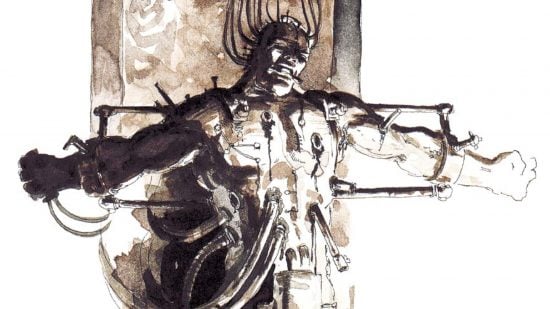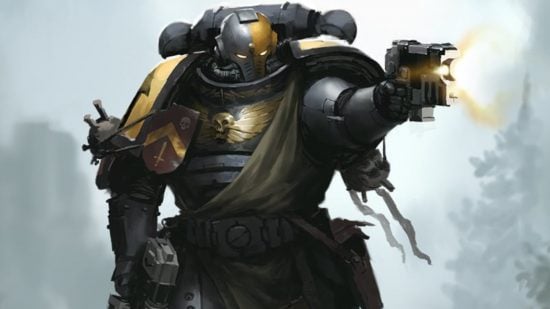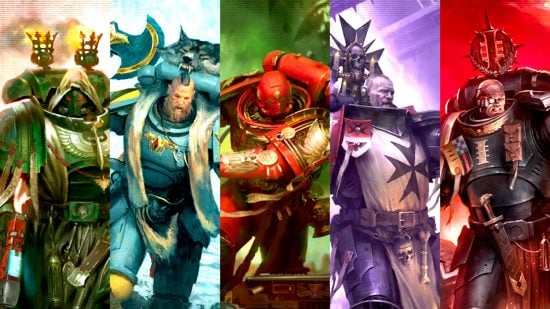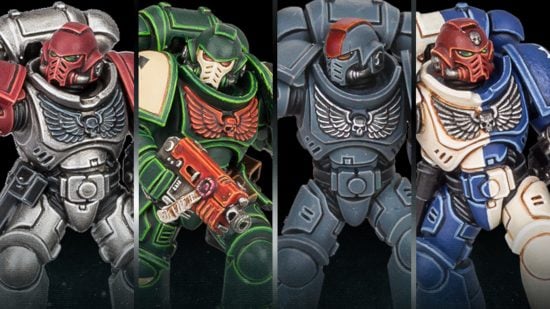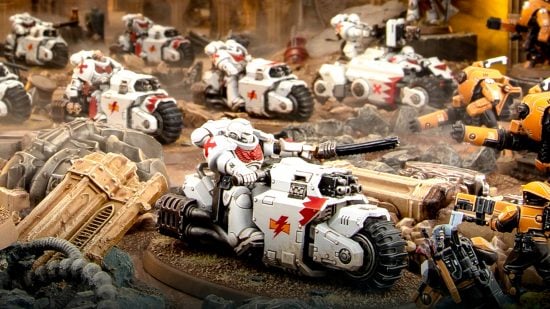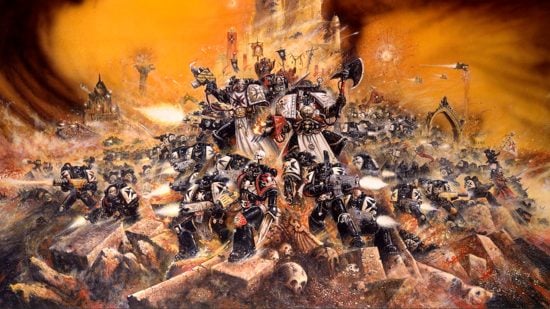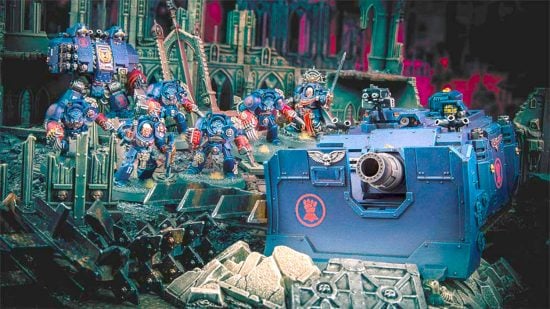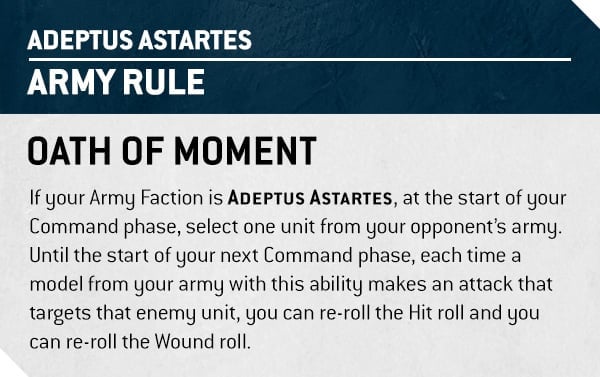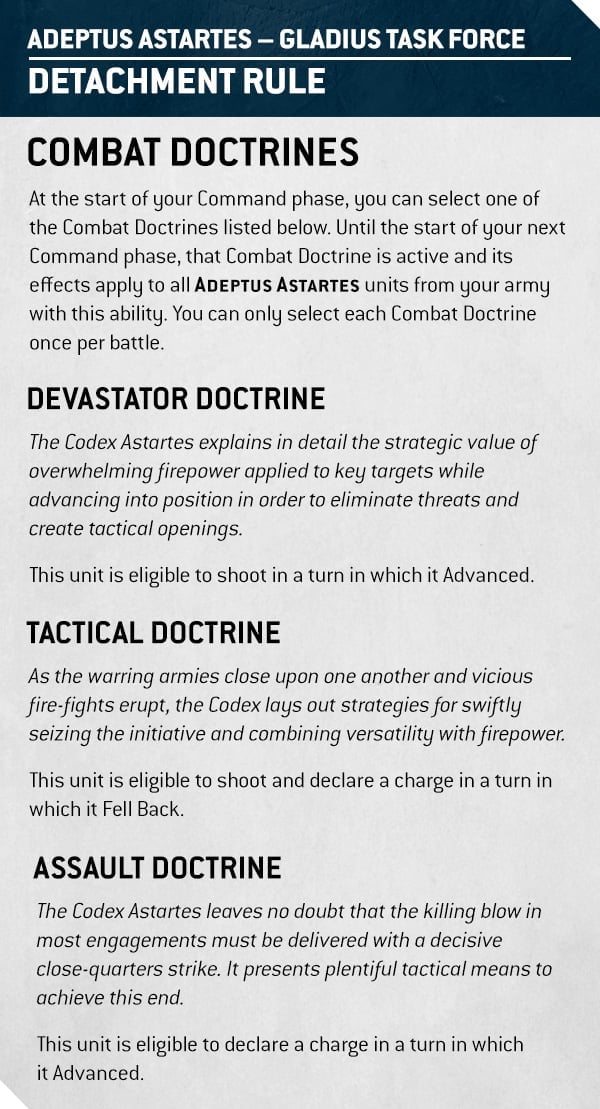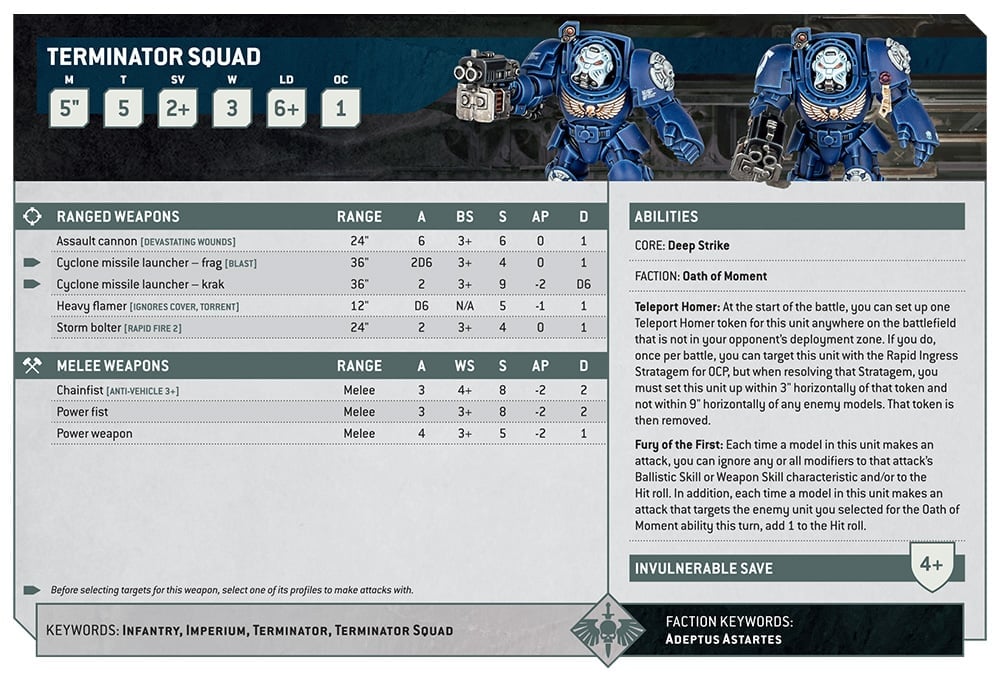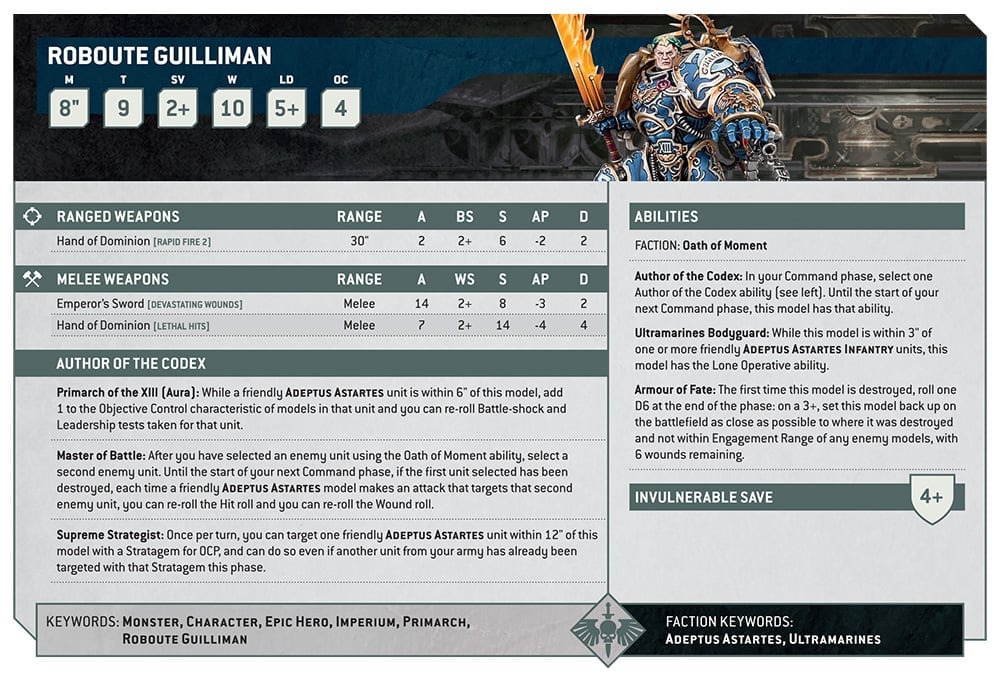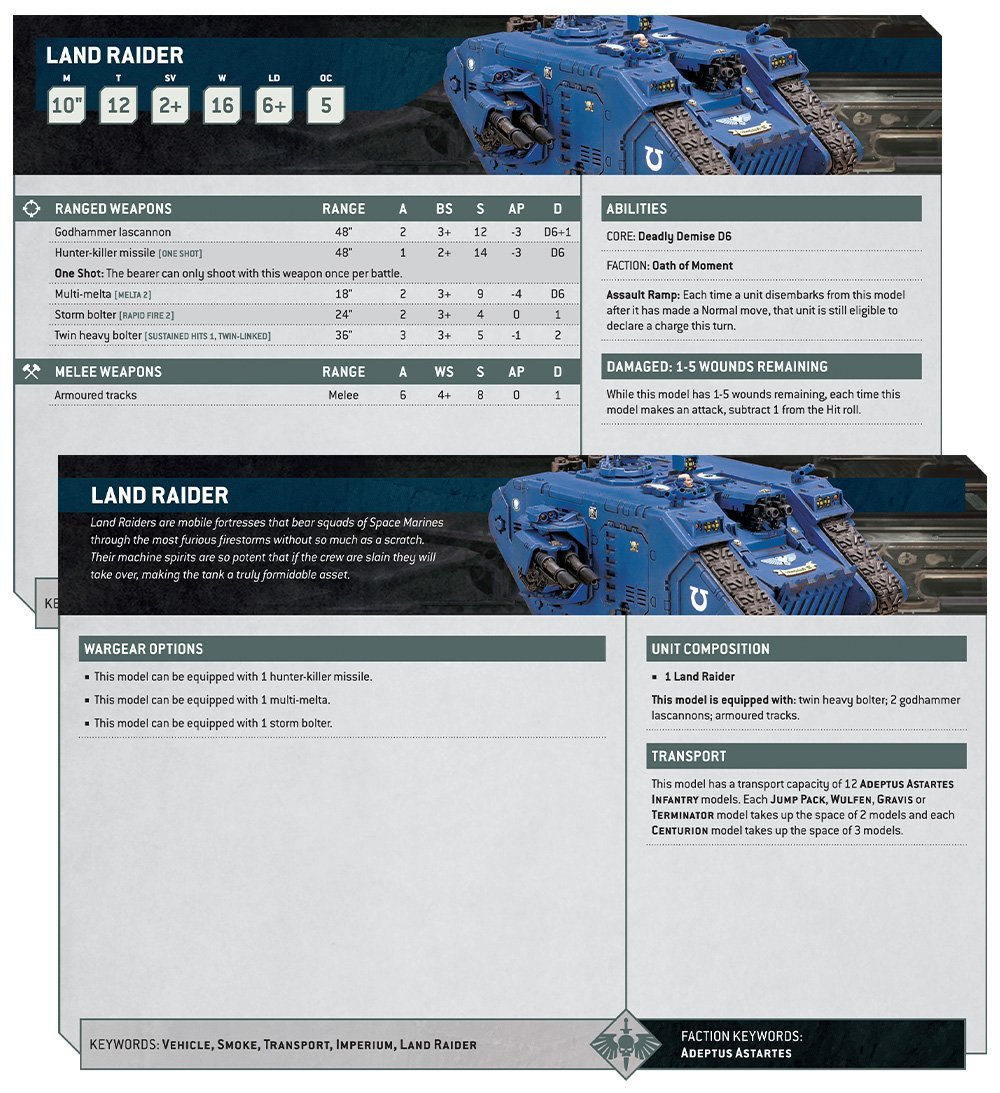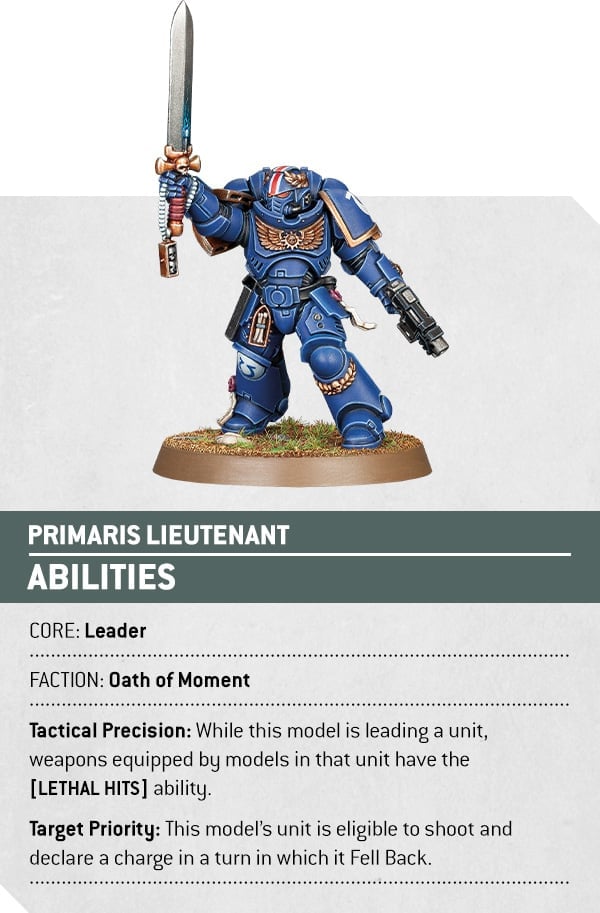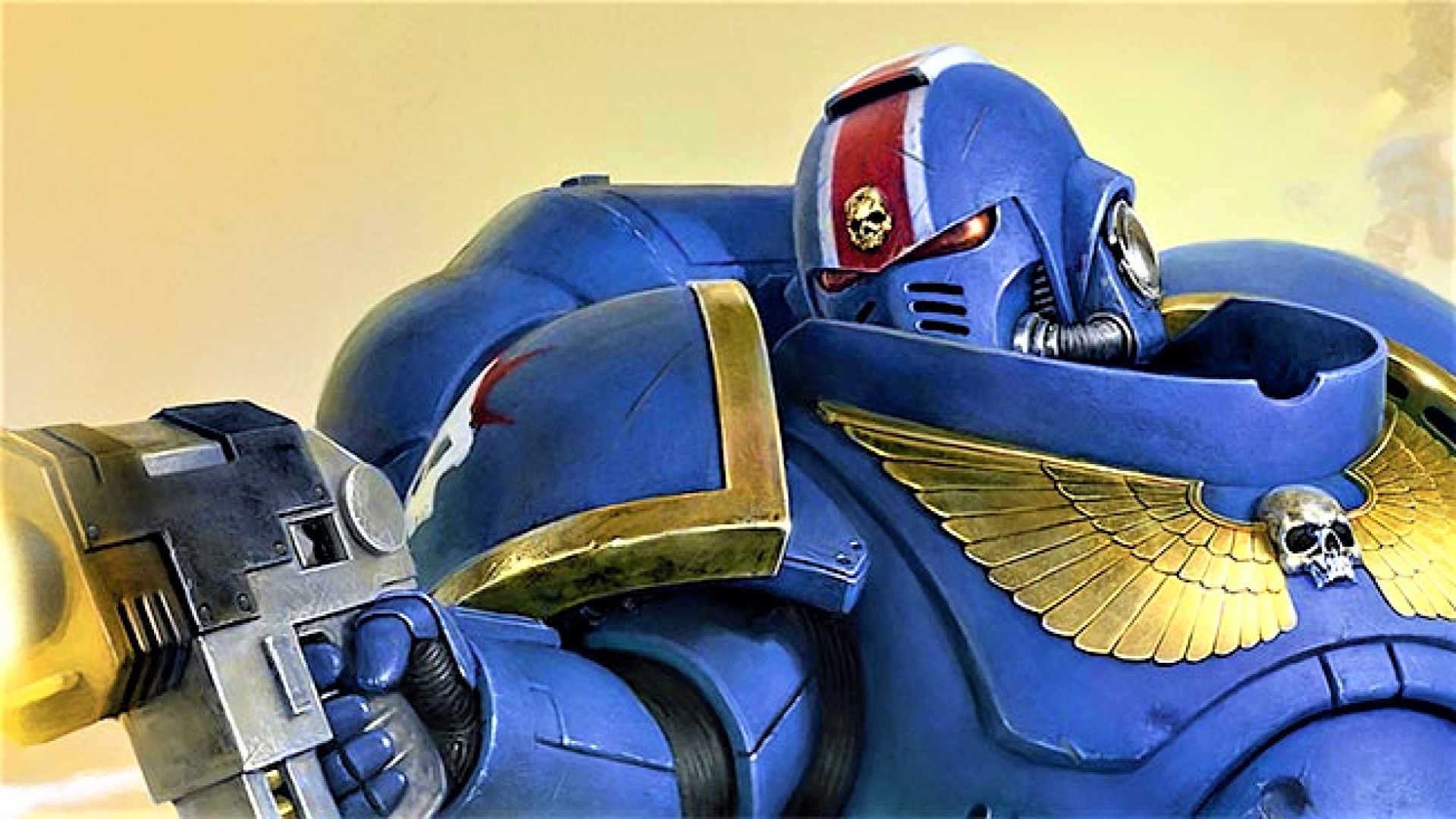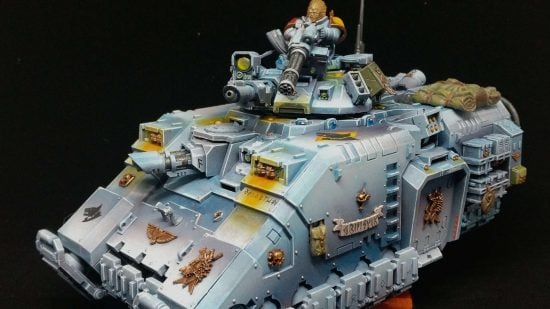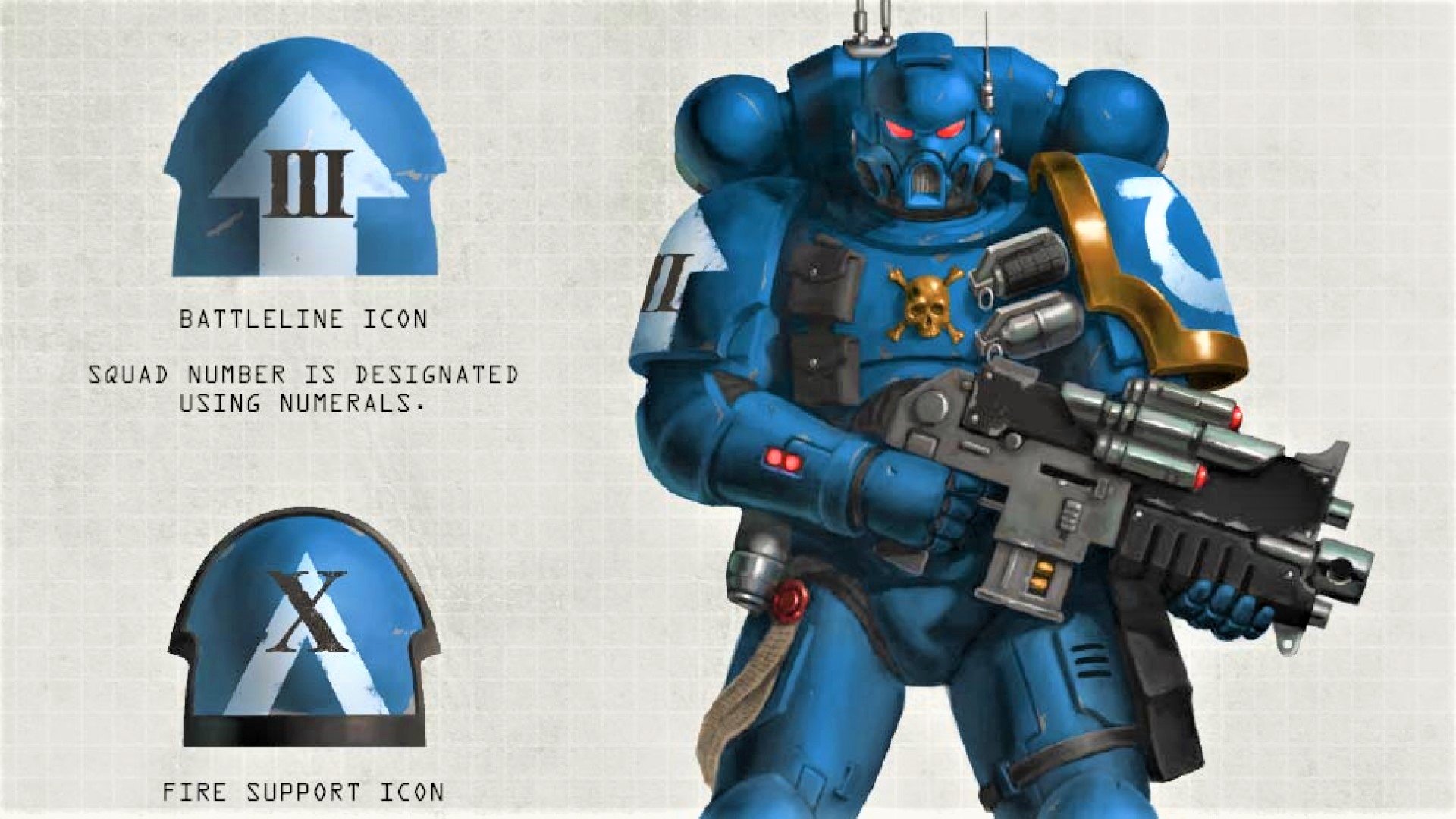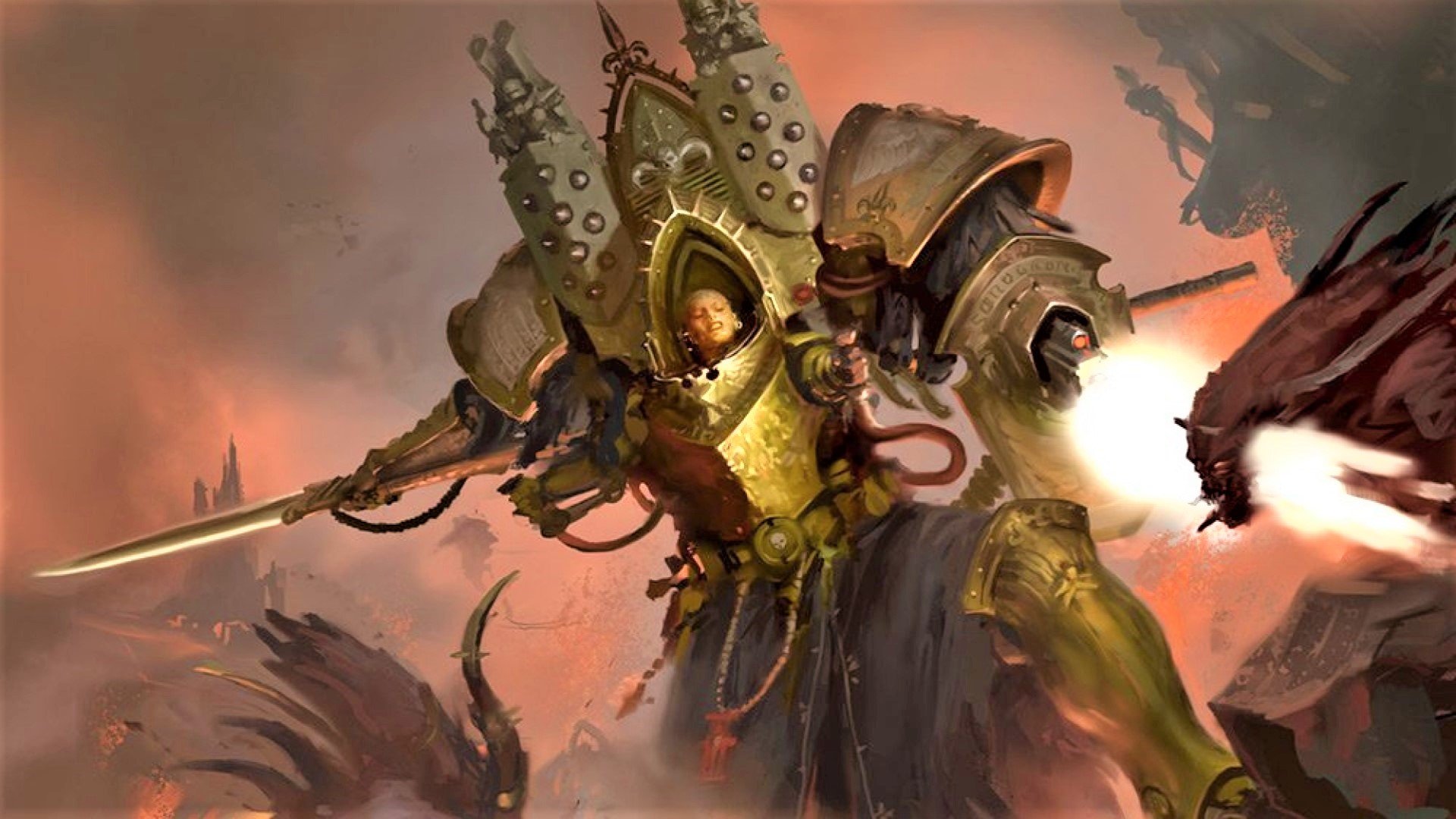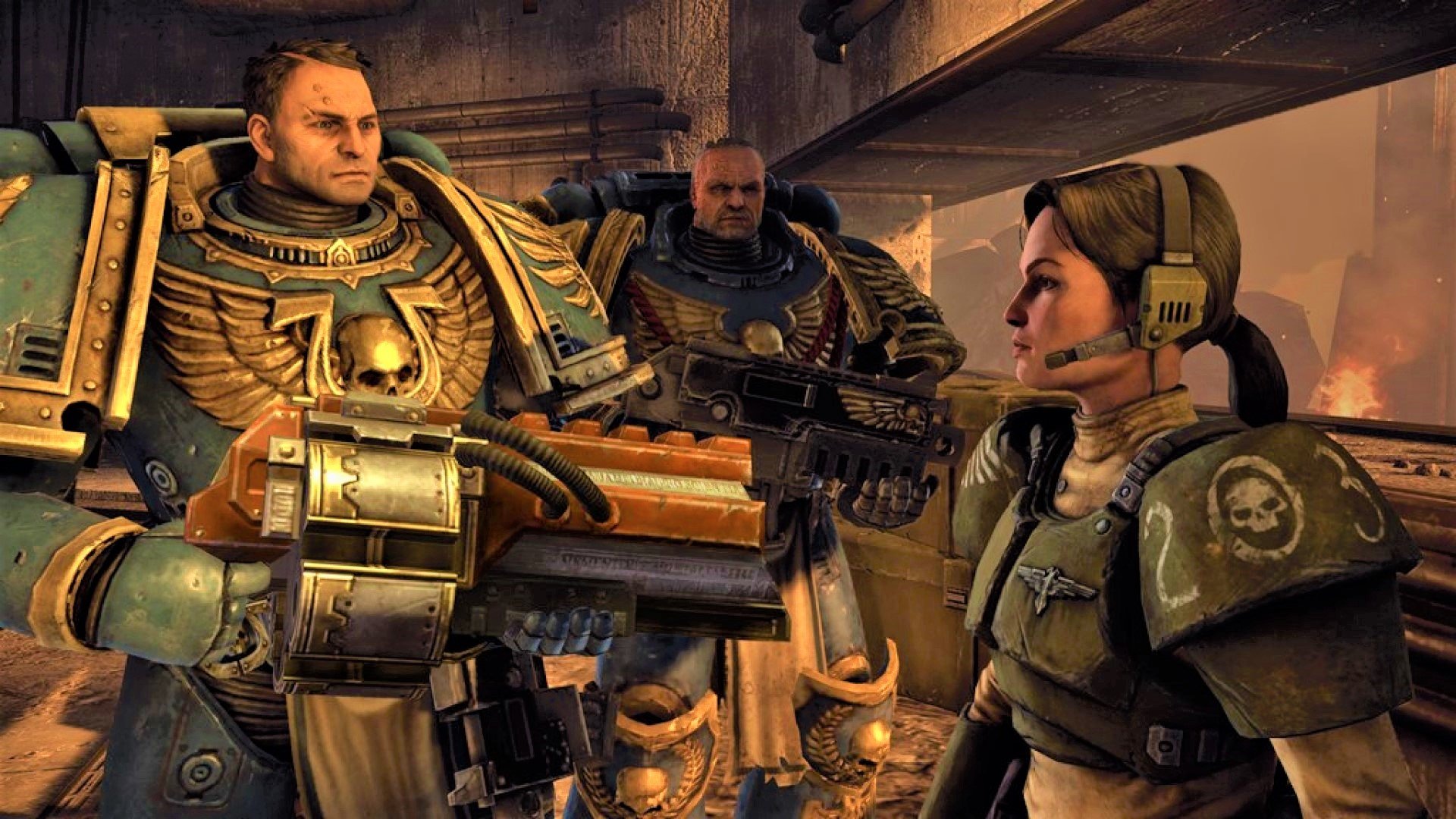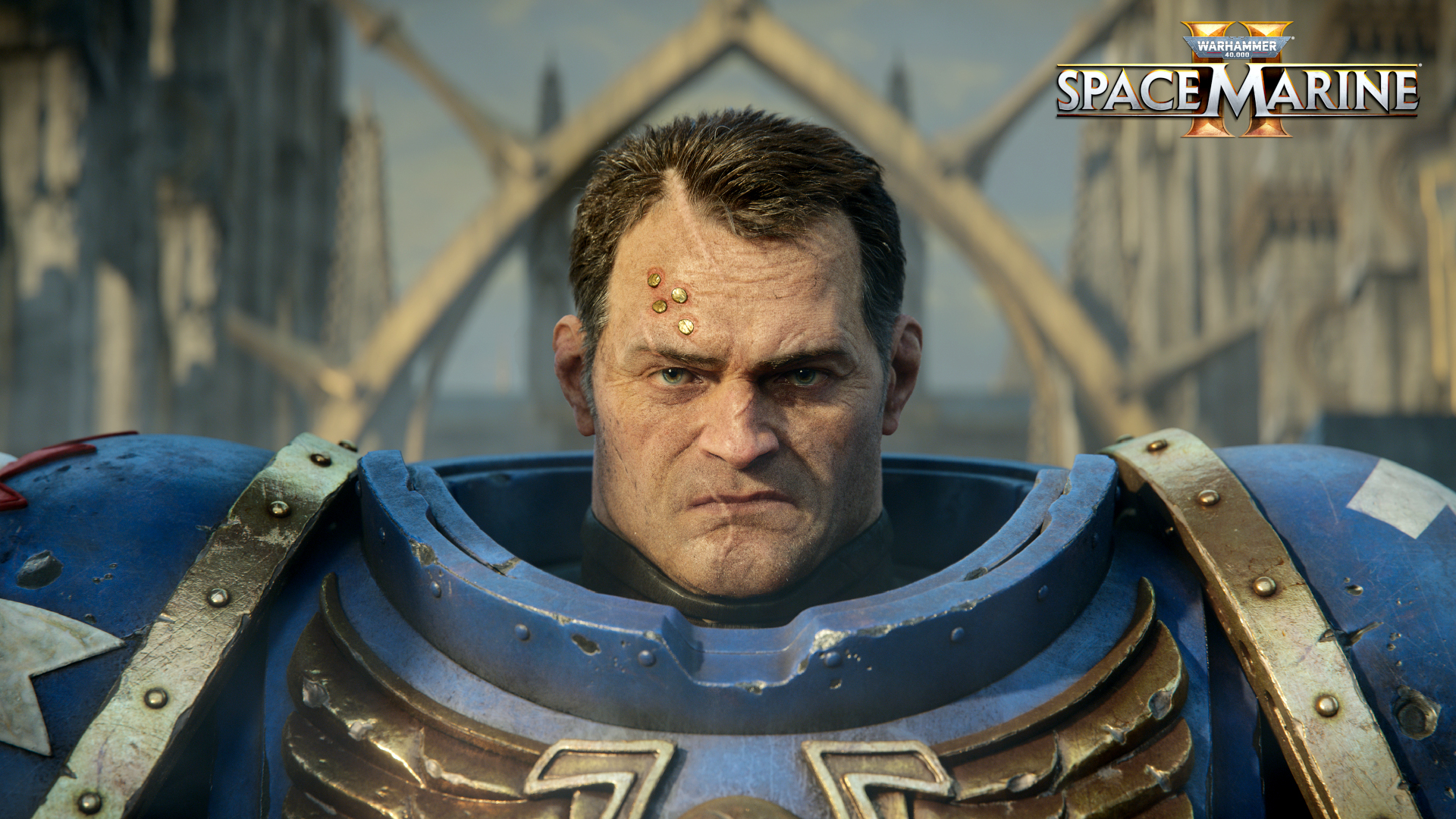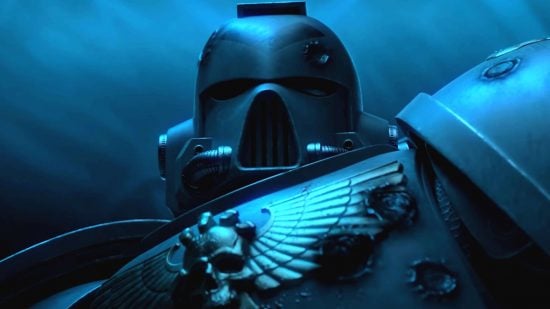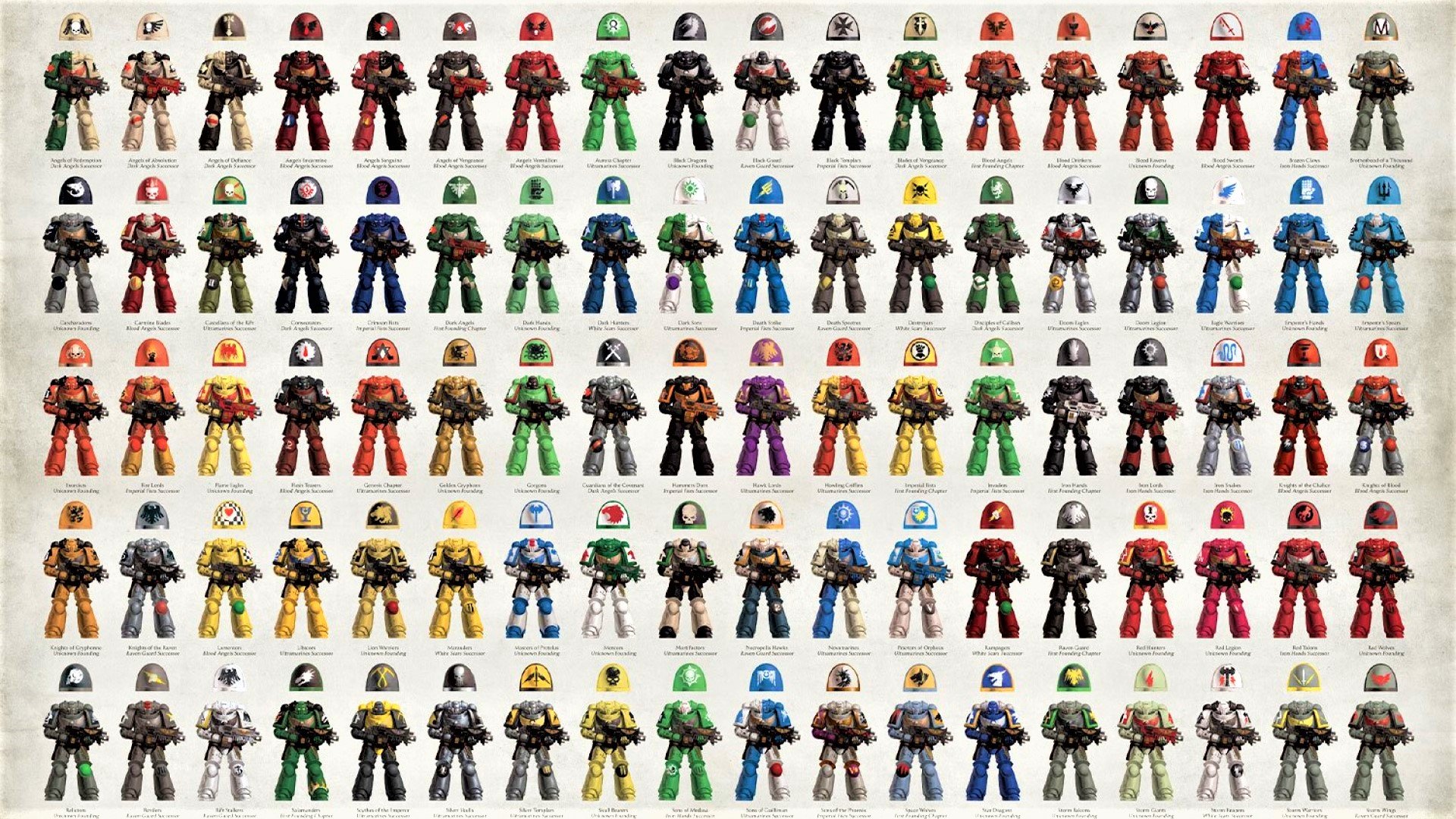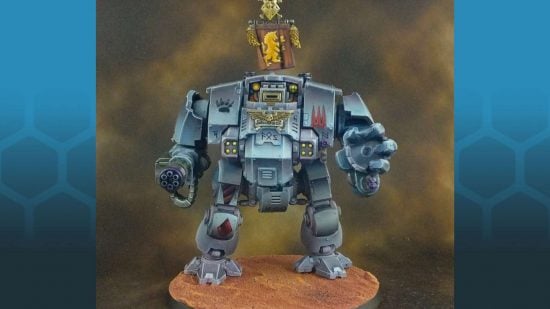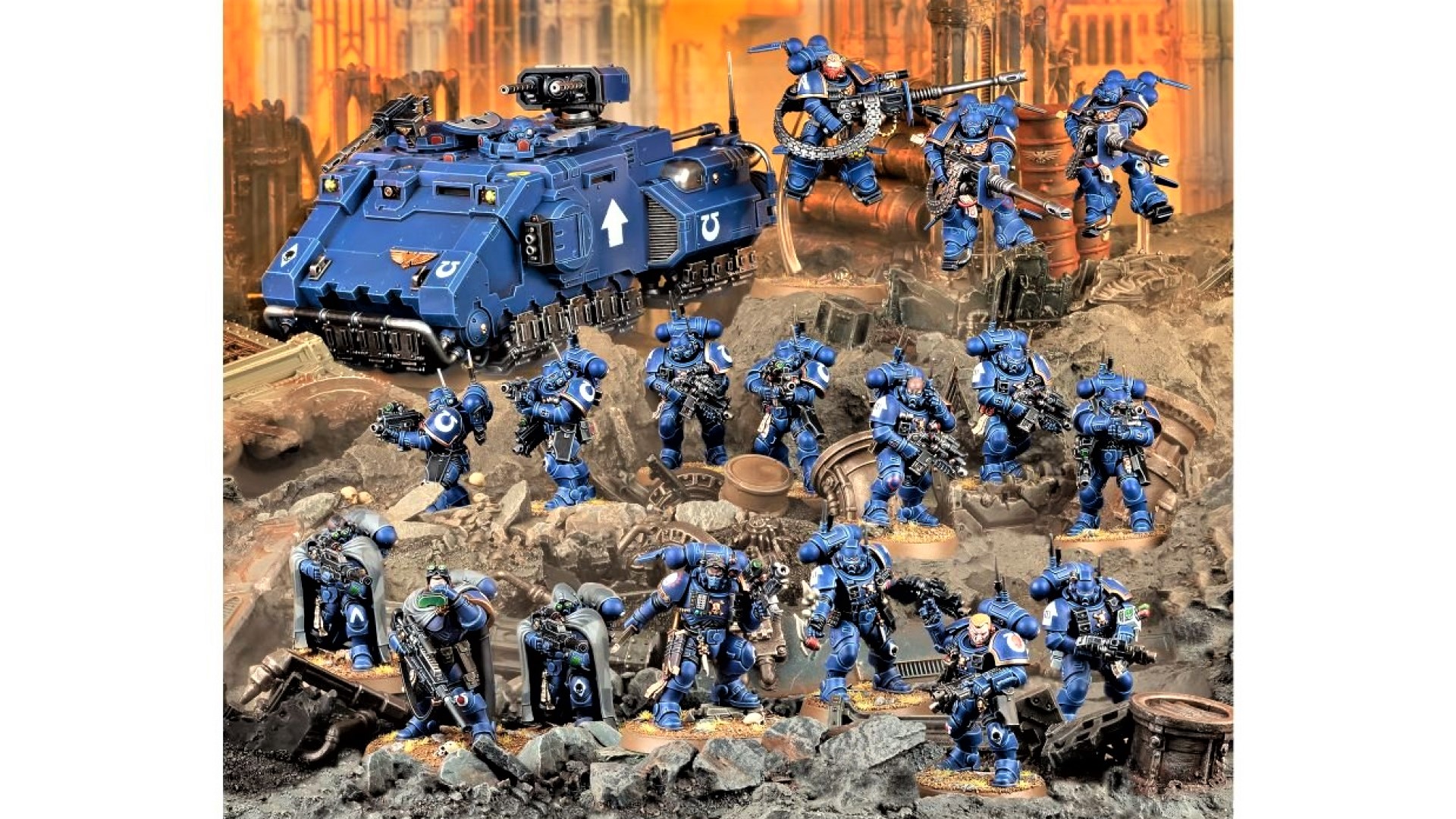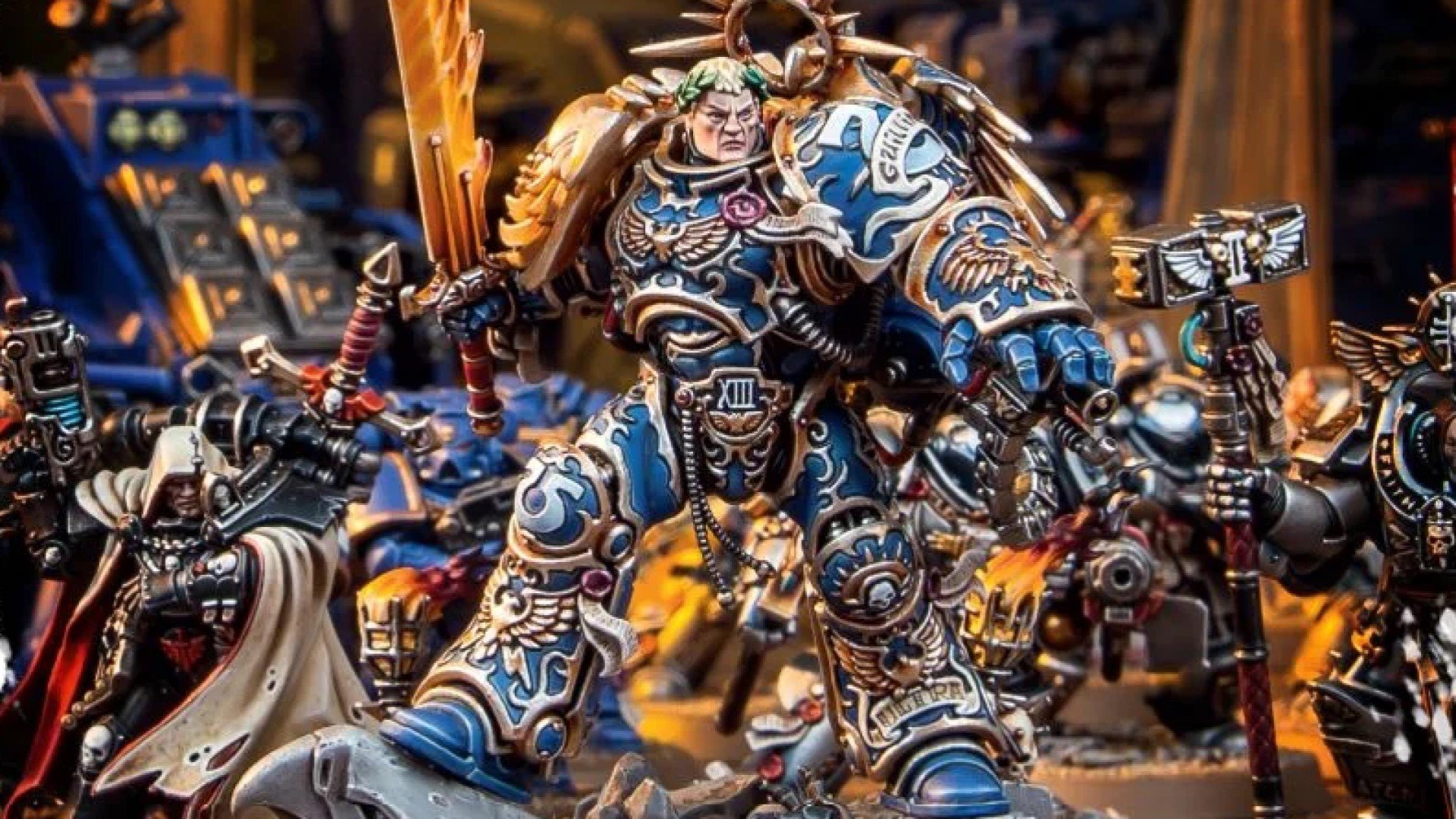Warhammer 40k Space Marines are the most famous, popular, and prominent army in Games Workshop’s sci-fi tabletop game. The power-armored super-soldiers of the Adeptus Astartes are a perpetual favourite on the tabletop, supported by a vast range of miniatures. This guide explains everything you could possibly need to know about them.
The chances are you’ve seen at least one Space Marine before; these defenders of the Imperium of Man have been the public face (or rather faceplate) of GW’s sci-fi wargame since its inception in 1987. There are flavors of Space Marine to suit every palette, so much so that we have a whole separate guide to the Space Marine chapters and legions.
The complete guide to Space Marines:
More than any of the other Warhammer 40k factions, Space Marines take the centre spotlight, whether in the lore-rich Horus Heresy book series, or the hundreds of distinct models backed up by rules in their Warhammer 40k codex army list.

What is a Space Marine?
Space Marines – also known as the Adeptus Astartes – are surgically enhanced, mentally indoctrinated super-soldiers, who wield the most powerful arms and armor available to the Imperium of Man. They are fanatically loyal to the Emperor of Mankind – trans-human special forces created to the Emperor’s own arcane design – and it’s their job to fight his deadliest enemies, at the sharp end of all humanity’s wars.
Each Space Marine begins life as a human adolescent, and is selected to enter a chapter through a series of gruelling trials. Those who survive receive a series of genetically-engineered implants, or “geneseed”. Some are additional organs, like the third lung and second heart, while others alter their metabolism and enable the other implants to function.
The final implant, the black carapace, allows the neophyte to wear Space Marine armor. Via the black carapace, a Space Marine can form a direct mental bond with their power armor, affording them complete control over this strength-enhancing mechanical exoskeleton.
Even without their bulletproof ceramite plate, however, Space Marines’ artificial organs and ‘gen-hanced’ transhuman physiology makes them functionally immortal, immune to all natural disease, able to survive grievous wounds, and gifted with a bevy of superhuman abilities.
The Omophagea, for example, allows them to absorb a life form’s memories by eating its flesh. The Catalepsean Node allows them to remain awake indefinitely without sleep, only requiring limited, semi-conscious rest. In a pinch, the Betcher’s Gland allows them to spit corrosive acid at enemies.
Space Marines are heavily indoctrinated with psycho-conditioning. This ensures their loyalty to the Emperor – for the threat of a Space Marine slipping their mental bonds and succumbing to the Warhammer 40k Chaos powers is too great to be ignored (read our Chaos Space Marines guide for more info).
Adeptus Astartes warriors may go to battle in any one of myriad different configurations and loadouts, kitted out for various specialised battlefield missions. Spaceship boarding, stealth assassinations, crowd control, massed assaults, armored blitzkrieg – you name it, Space Marines can do it.
Almost all chapters start out their new recruits as lightly-armored scouts – but, once they graduate from that role (after a few decades in the field, usually), marines are re-equipped and redeployed in any one of countless units, from standard line soldiers and jump-pack shock troops, to expert vehicle crews, to the fearsome, elite Space Marine Terminators.
Space Marine Chapters
In the 41st millennium (and, per the current lore, the opening years of the 42nd) the Space Marines are organised into a number of distinct, independent fighting forces known as Space Marine Chapters.
We have a whole guide dedicated to explaining the many Space Marine Chapters – and the ancient Legiones Astartes that preceded them – so for the full story, click that link. For now, we’ll provide an overview of what they are, how they operate, and name a few of the most prominent chapters at large in the 40k universe.
What is a Space Marine chapter?
A Space Marine chapter is a discrete, organised fighting force of Adeptus Astartes warriors, with its own proud name, history, color scheme, symbology, and heraldry. It’s usually led by a single Chapter Master and, beneath them, split into multiple units (normally called companies) commanded by senior officers.
Most chapters keep their own fleets of void-borne warships and armories of weapons, munitions, and Warhammer 40k tanks – all maintained with the assistance of allied tech-priests from the Adeptus Mechanicus, whose hallowed task it is to keep all Imperial technology in working order.
Beyond that core definition, chapters often differ wildly from each other, in terms of their numbers; their philosophies and priorities; their power structures and organisation; and especially in their preferred weaponry and ways of war.
Space Marine chapters may protect a region of Imperial space based around their home-world, or they may travel the galaxy on mighty crusades to drive back the Xenos races and forces of Chaos that threaten mankind. Many chapters have no home-world, instead maintaining a base of operations in a mobile fortress monastery ship.
Chapters even diverge from one another at the level of basic genetic makeup. Every chapter officially claims its genetic heritage from the gene-seed of one of the original Warhammer 40k primarchs. But, after 10,000 years of warfare, losses, reinforcements, and extremely shoddy record-keeping, it’s more or less impossible to be sure how true those claims are any more. That’s doubly true for the new Primaris marines (more on them later).
There are thought to be 1,000 chapters in the Imperium of Man, each numbering around 1,000 marines. If that’s true, then there’s at least one Space Marine for every world in the Imperium – but in reality there are almost certainly far more than that.
You see, the chapters were originally created according to the Codex Astartes, a war manual written by Ultramarines primarch Roboute Guilliman which formally limited the size of each Space Marine army to 1,000. This, he hoped, would prevent any one Astartes force from becoming too powerful and turning against the Imperium, as happened in the disastrous Horus Heresy era, when Space Marine legions united tens of thousands of Astartes under one banner.
But, while many so-called ‘codex compliant’ chapters still follow these restrictions in the 41st millennium, a significant number definitely don’t – including the Black Templars and Space Wolves, both of whom use their decentralised command structures as an excuse for maintaining forces of many thousands of marines at all times.
What are the most important Space Marine chapters?
Out of the roughly 1,000 chapters waging war across the galaxy, only a couple of dozen are well known to us, enjoying prominence in Games Workshop’s novels, lore texts, videogames, and other media, as well as their own unique, named characters and miniatures.
Chief among these are the so-called First Founding chapters – those which were formed directly from the original loyalist Space Marine legions, seven years after the Horus Heresy ended, and kept their former names, colors, insignia, and genetic code.
The First Founding chapters are:
Also among the ranks of the famous are a few successor chapters – a generic name for all other chapters. It’s helpful to split these into two categories:
- Second Founding chapters – formed from the rest of the dissolved legions, at the same time as the nine core, First Founding chapters.
- Other chapters – the many hundreds of new chapters founded over the following 10,000 years (plus a few special cases)
The most prominent successor chapters are:
| Chapter name | Chapter Master (or equivalent) | Successor of |
| Black Templars | High Marshal Helbrecht | Imperial Fists |
| Crimson Fists | Pedro Kantor | Imperial Fists |
| Flesh Tearers | Gabriel Seth | Blood Angels |
| Lamenters | Malakim Phoros | Blood Angels |
| Emperor’s Spears | High King Arucatas | Ultramarines |
| Fulminators | Unknown | Ultramarines |
| Hawk Lords | Unknown | Ultramarines |
| Novamarines | Bardan Dovaro | Ultramarines |
| White Consuls | Ridian Artemanis | Ultramarines |
| Carcharodons | Shade Lord Tyberos ‘The Red Wake’ | Raven Guard (unconfirmed) |
| Raptors | Lias Issodon | Raven Guard |
| Blood Ravens | Gabriel Angelos | Unknown |
| Minotaurs | Asterion Moloc | Unknown |

How to play Space Marines in 10th edition
We’re not sure if you’ve heard, but Warhammer 40k 10th edition is here – and, on the tabletop, 10th Edition Space Marines look to be as strong, flexible, and accessible an army as they’ve always been.
The Astartes still have a vast roster of units to choose from, they get a very powerful faction rule in Oath of Moment, and a strong detachment rule in Combat Doctrines (more on those below). Plus, as disciplined elite troops with generally high Leadership stats, they stand to perform better than most in terms of Battle-shock, the new edition’s crucial morale mechanic.

Space Marines Oath of Moment
The Space Marines Oath of Moment is a solemn vow that the Astartes swear before embarking on a mission. In 10th edition, this provides a simple and powerful force multiplier. Each Command phase you’ll pick a single enemy unit, and your entire army will be able to re-roll Hit and Wound rolls whenever it targets that unit with an attack.
Space Marines Gladius Task Force Detachment
The Space Marines Gladius Task Force Detachment will be included with the free Index rules when 10th edition launches. Warhammer 40k detachments work differently in 10th edition 40k compared to ninth. Each detachment provides your force with army-wide rules, six 40k stratagems, and a set of enhancements (similar to Warlord Traits or Relics), and may impose restrictions on how you construct your list.
The Gladius Task Force provides access to Combat Doctrines. These reflect the tactical flexibility of a standard marine force. There are three doctrines, each of which can be used once per game at the start of a Command phase, and each of which provides a different buff.
| Doctrine | Effect |
| Devastator | Weapons gain the Assault ability |
| Tactical | Units can shoot and charge in the same turn as falling back from melee |
| Assault | Units can charge after advancing |
Assault doctrine extends your melee threat range, which could be a core gameplan for a melee-focused army, or a useful tool for balanced lists to claim objectives. The Devastator doctrine project the threat from your guns further, or allows you to claim objectives and still fire effectively with all your weaponry. Tactical Doctrine is a great defensive tool against melee-focused enemies, or a way to maintain momentum if your own assault gets bogged down by a tough enemy.
Space Marine Stratagems
The Gladius Task Force Detachment comes with six Space Marine stratagems. Some of these have special effects when a particular Doctrine is in effect. These can only be used by Space Marine units, so if your force includes a Freeblade Imperial Knight, it won’t benefit.
| Stratagem | Cost | Effect | Doctrine bonus |
| Only in Death does duty end | 2CP | Just after the enemy picks one of your units as its target in the Fight phase; until the end of the phase, whenever one of the models in your unit is destroyed, if it hasn’t fought yet, it gets to fight before its model is removed. | N/A |
| Honour the Chapter | 1CP | For one fight phase, one unit gains the Lance ability on its melee weapons. | Assault: Improve AP by one |
| Armour of Contempt | 1CP | Just after an enemy unit targets one of your units in the shooting or fight phase; until the end of phase, worsen the AP of attacks targeting that unit by one. | N/A |
| Adaptive Strategy | 1CP | In the command phase, select a doctrine and a unit. Until your next Command phase, that unit is under the effects of that doctrine no matter what your army is using. | N/A |
| Storm of Fire | 1CP | Pick a unit about to shoot; it Ignores Cover this phase. | Devastator: Improve AP by one |
| Squad Tactics | 1CP | After an enemy unit ends any kind of move within 9″ of one of your unengaged infantry or mounted units, your unit can move D6″ | Tactical: move 6″ instead |
Warhammer 40k 10th edition Space Marine Chapters
In Warhammer 40k 10th edition Space Marine chapters don’t have the same role that they did in 8th and 9th edition. All Space Marine chapters share the same Oath of Moment army rules. Some Units and Epic Heroes have keywords that indicate they’re part of a particular chapter.
However, these keywords only come into play with certain Detachments: for example, marines with a chapter keyword other than Space Wolves can’t join the Sons of Russ Detachment. But you could use specialist Space Wolves units in a standard Gladius Task Force Detachment, and even mix them in with Ultramarines.
Warhammer 40k 10th edition Space Marine datasheets
Games Workshop has previewed several Warhammer 40k 10th edition Space Marine datasheets and snippets.
Space Marine Terminators
Space Marine Terminators now have a chunky toughness of five and 4+ invulnerable save. Their Teleport Homer can be placed anywhere outside the opponent’s deployment zone: during the battle they can deploy close to the Teleport Homer at the end of the opponent’s movement phase, using the new Rapid Ingress Stratagem. They’re not the only unit that will be able to use the Stratagem, but Terminators using a Teleport Homer can do so for no CP.
Space Marine Terminator Librarian
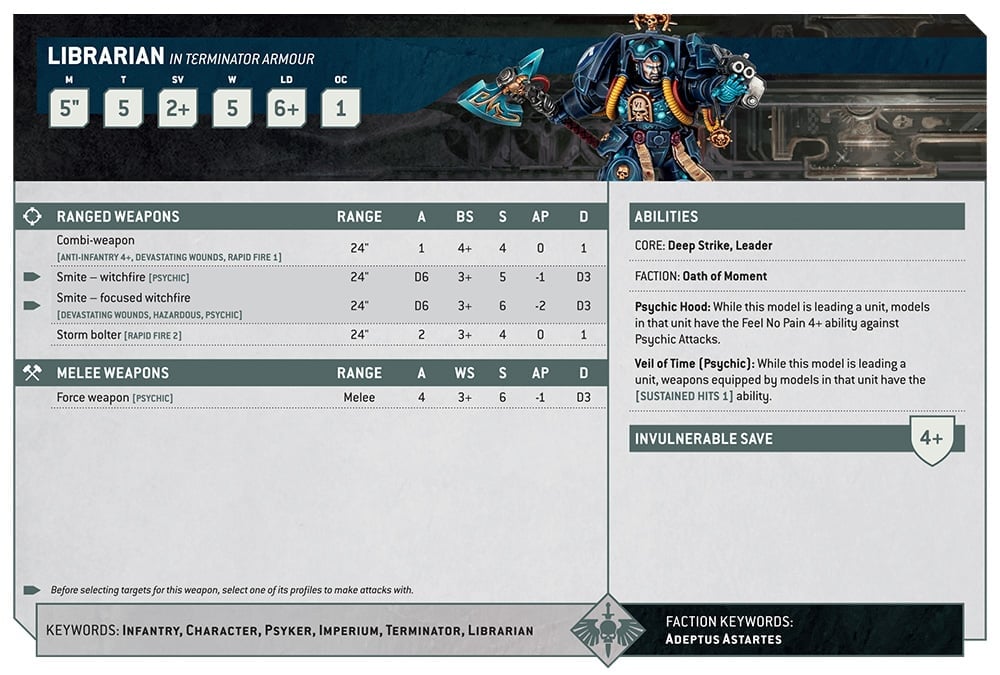
The Space Marine Terminator Librarian has similarly improved Toughness and Invulnerable save. He also demonstrates how psychic abilities have been reworked for the new edition of 40k. His psychic power Smite is now a shooting attack, while Veil of Time grants a unit that he is leading the Sustained Hits 1 Weapon Ability, meaning their to-hit rolls of six score an additional hit.
Space Marine Rhino
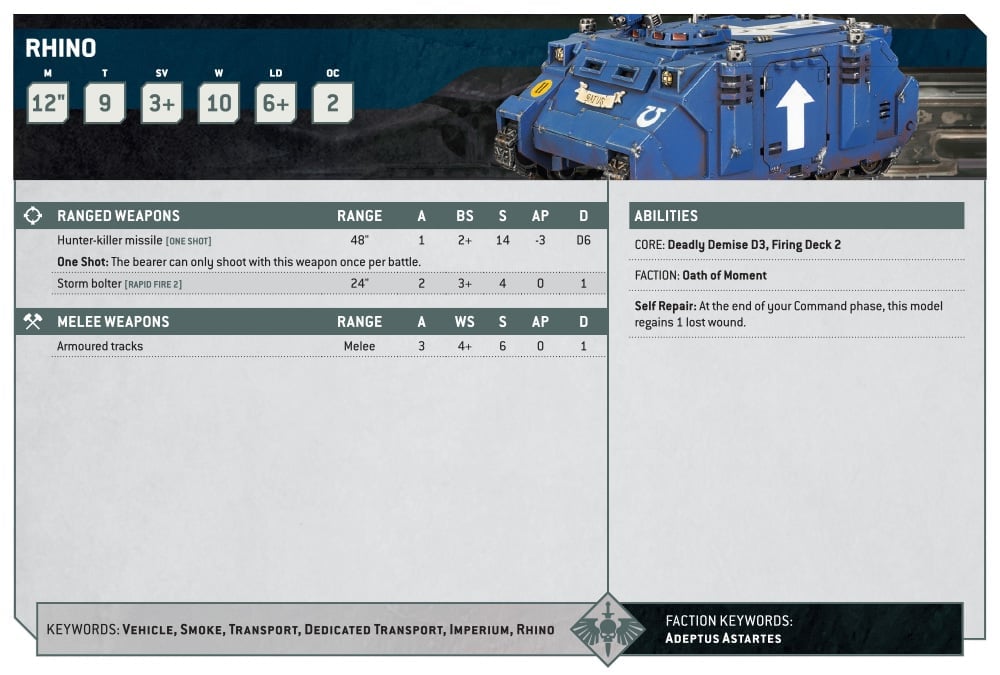
The Space Marine Rhino armored transport is a little tougher than it was in ninth edition, and regains the ability to self-repair, and for models to fire out of its top hatch as it did in older editions of 40k.
Roboute Guilliman
Primarch Roboute Guilliman is a super-sized commander and force multiplier. He has substantial melee prowess with the Emperor’s Sword and Hand of Dominion, which will reap through infantry and enemy armor respectively, but his main capability is as a leader.
His ‘Author of the Codex’ ability grants him a choice of three auras each command phase. ‘Primarch of the XIII’ boosts the Objective Control stat and resilience to Battle-shock of Marines within 6″; Master of Battle allows you to pick a second enemy unit to target with an Oath of Moment (though you must destroy the first target before moving onto this one); and Supreme Strategist allows you to target a marine unit within 12″ with a Stratagem for 0CP, even if you use that Stratagem on another friendly unit in the same turn.
What with his golden halo, Guilliman is just too obvious a target to benefit from the Leader ability which would allow him to hide inside a unit. However, the ‘Ultramarines Bodyguard’ ability means he benefits from the Lone Operative ability while within 3″ of a Space Marine infantry unit, meaning enemies can’t target him until they’re within 12″.
Once close enough, they have to contend with Toughness nine, 10 wounds, a 2+ save and 4+ invulnerable save. And should he be slain, the armor of Fate allows him to return from death on a roll of 3+. In short, he looks like an absolute unit.
Space Marine Land Raider
The Space Marine Land Raider‘s model is the size of a brick, and it has appropriate rules: Toughness 12, 16 Wounds, and a 2+ save, in an edition where armor-penetration is restricted to dedicated anti-tank ordnance. The Assault Ramp on the front of the Raider allows a unit to disembark from it to charge in the same turn, even if the Raider moved first.
Primaris Lieutenant
Games Workshop revealed the leadership capabilities of the ubiquitous Primaris Lieutenant on April 11. Most characters in 10th edition will boost troop effectiveness by joining units, rather than projecting a buffing aura. The unit the Primaris lieutenant joins will score automatic wounds on to-hit rolls of six, by granting them the Lethal hits weapon ability. The unit can also declare a charge or shoot in a turn when it falls back.
Most units can only be joined by one Leader, but the Lieutenant can serve as a second-in-command alongside a unit lead by a Captain or a Chapter Master.

Leviathan Space Marines
After a thunderous appearance in the 10th edition announcement trailer back in April 2023, GW revealed 25 new Space Marine sculpts in the Warhammer 40k 10th edition Leviathan launch set.
Leviathan is packed with new Space Marine models for 10th edition, including:
- Captain in Terminator armor
- Librarian in Terminator armor
- Space Marine Terminators x 5
- Apothecary Biologis in Gravis armor
- Infernus Squad x 10
- Vanguard Veterans x 5
- Ballistus Dreadnought
- Lieutenant in Phobos armor
About half of these models will be available in the new Warhammer 40k Starter Sets for 10th edition; the Ultimate Starter Set contains the Captain, Librarian, Terminators, and five Infernus marines, and constitutes the new Space Marines Combat Patrol.
Primaris Space Marines
The Primaris Space Marines are the pinnacle of transhuman soldiery, a more physically advanced, better equipped, upgraded version of the Space Marines, engineered over ten millennia by Archmagos Dominus Belisarius Cawl – an ingenious, eccentric, and decidedly dangerous senior Tech-priest of the Adeptus Mechanicus.
Introduced to the tabletop game and the fiction at the same time, with the launch of Warhammer 40k’s 8th Edition in 2017, the Primaris Space Marines started off with a small selection of up-scaled Space Marine characters and units – but, in 2023, they’re basically a model range of their own.
Taller, stronger, and faster than the original ‘Firstborn’ Adeptus Astartes, clad in upgraded Mark X power armor, and equipped with a whole range of superior wargear, the Primaris marines do all the same things as their forebears – only better. In the lore, at least. In 10th edition, Primaris and old-style ‘Firstborn’ marines fill different battlefield roles, but have similar stats.

Almost all the Space Marine Chapters have now had large influxes of Primaris Space Marine reinforcements delivered by elements of Roboute Guilliman’s Indomitus Crusade – and, where Primaris and Firstborn have suddenly begun to fight together, friction, distrust, and culture shock have resulted.
Entire new Space Marine Chapters, such as the Fulminators and Rift Stalkers, have been formed entirely of Primaris marines, in the so-called Ultima Founding, ordered by Roboute Guilliman.
Even prominent leaders among the Firstborn Space Marines have undergone arcane and painful surgery to be converted into Primaris marines – led by Ultramarines Chapter Master Marneus Calgar, and followed by many others, including the Black Templars’ High Marshal Helbrecht.
The burning question – both on the tabletop, and canonically in Warhammer 40k lore – is: are the Firstborn marines on the way out? Will the new and improved Primaris breed entirely replace the original Adeptus Astartes that have held firm in defence of the Imperium of Man for 10,000 years? Only time will tell.
Primaris Space Marine units include:
| Unit | Armament | armor | Role |
| Intercessors | Boltrifles and variants | Tacticus | Troops |
| Heavy intercessors | Heavy boltrifles and variants | Gravis | Troops |
| Assault intercessors | Heavy bolt pistol and astartes chainsword | Tacticus | Troops |
| Veteran intercessors | As intercessors and assault intercessors | Tacticus | Elite |
| Hellblasters | Plasma incinerators and variants | Tacticus | Heavy |
| Aggressors | Boltstorm gauntlets or flamestorm gauntlets | Gravis | Elite |
| Inceptors | Paired assault bolters or plasma exterminators | Gravis | Fast |
| Eradicators | Melta rifles or heavy melta rifles | Gravis | Heavy |
| Bladeguard Veterans | Mastercrafted power swords and storm shields | Tacticus | Elite |
| Desolation squad | Indirect-fire castellan launchers, plus superkrak or superfrag missiles | Tacticus | (Probably Heavy) |
Primaris Space Marine vehicles include:
| Vehicle | Chassis | Role |
| Redemptor Dreadnought | Redemptor | General support walker |
| Brutalis Dreadnought | Redemptor, up-armored | Front-line melee walker |
| Repulsor | Repulsor | Heavy troops carrier and support weapon platform |
| Impulsor | Impulsor | Light troops carrier |
| Repulsor Executioner | Redemptor | Heavy tank and limited troops carrier |
| Storm Speeder Hailstrike | Storm Speeder | Mobile anti-infantry |
| Storm Speeder Thunderstrike | Storm Speeder | Mobile heavy fire platform |
| Storm Speeder Hammerstrike | Storm Speeder | Mobile anti-tank |
| Gladiator Lancer | Impulsor | Light, ranged tank-hunter |
| Gladiator Reaper | Impulsor | Light anti-infantry |
| Gladiator Valiant | Impulsor | Light, close tank-hunter |
Vanguard Space Marines
The Vanguard Space Marines, introduced to both the tabletop game and Warhammer 40k lore in the 2019 Shadowspear box set, are a specialised sub-set of the Primaris Space Marines, kitted out for covert operations, stealth, sabotage, and reconnaissance.
Vanguard Space Marines wear a modified version of the standard Primaris Mark X power armor, designated ‘Phobos’ pattern, which does not alter their in-game defensive stats, but does make them eligible for certain stratagems and psychic powers.
Probably the most popular Vanguard Space Marine units have been the Infiltrators and Incursors – alternative Troops choices to the vanilla Primaris Intercessors, which each offer their own added tactical advantages.

Both units can deploy anywhere on the board more than 9″ from enemy units; the Infiltrators have an aura that blocks enemy Deep Strikes, and can use a five-point upgrade to benefit from your HQs’ aura buffs wherever they are; while the cheaper Incursors have boltguns that ignore cover, and can place anti-vehicle Haywire Mines.
Prominent Vanguard Space Marine units include:
- Infiltrators
- Incursors
- Reivers
- Suppressors
- Eliminators
Female Space Marines
So, why aren’t there any female Space Marines? As you might imagine, it is a vexed question.
Women can join the Astra Militarum, a.k.a. Imperial Guard; women fight the enemies of the Imperium as Sisters of Battle; women have equal status in the Adeptus Mechanicus; and women have always served at all ranks in the Imperial Navy, as well as every level of the civilian government, in all corners of the galaxy-spanning empire of humanity. So why are there no women in the Emperor’s most elite fighting forces?
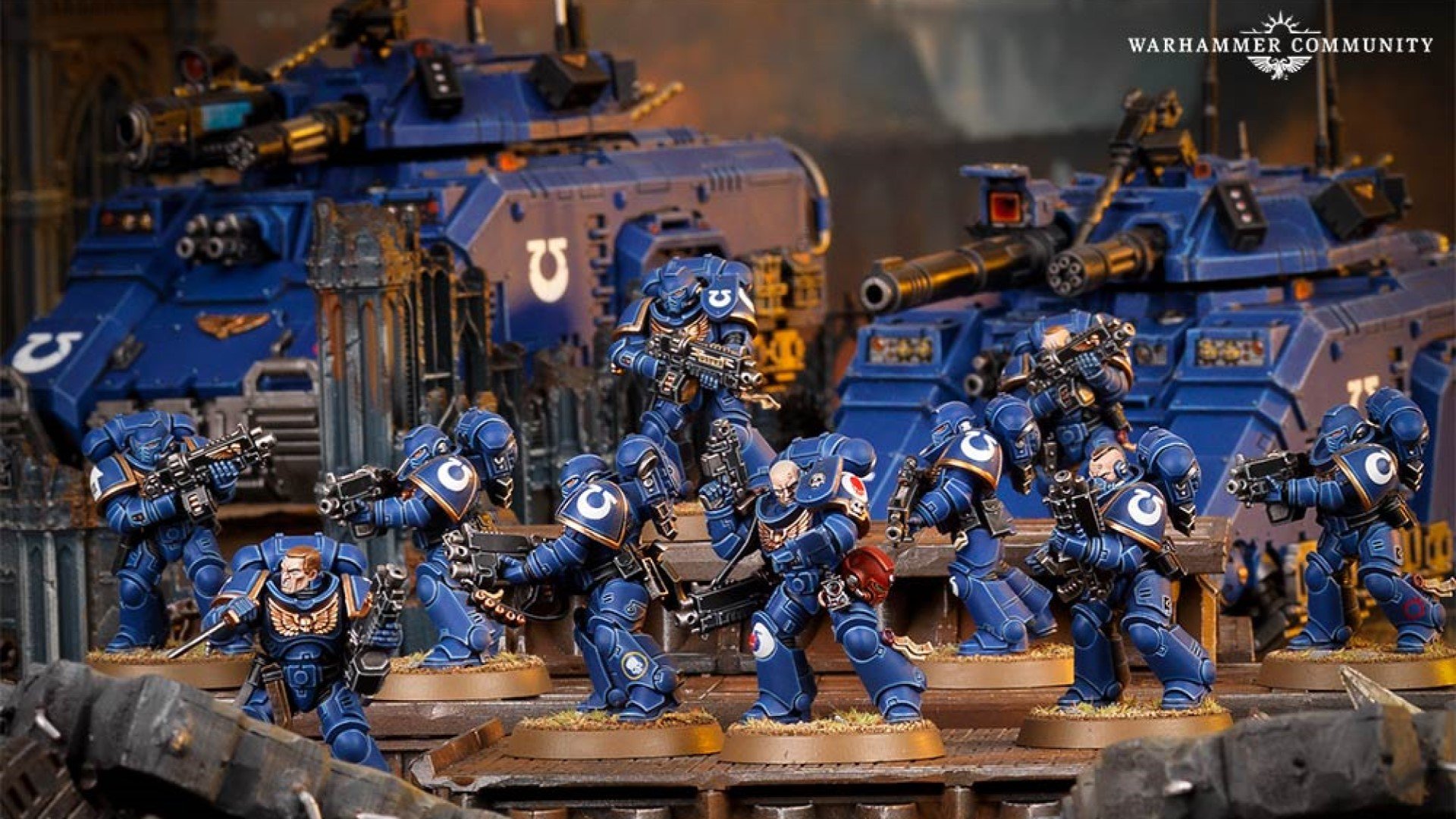
The commonly heard in-universe answer (usually made up on the spot by sexually insecure male Warhammer fans, for whom the existence of powerful, dominant, and especially combatant female characters in any fiction is inexplicably enraging) normally involves a lot of waffle about how the Emperor’s gene-crafting processes ‘just weren’t designed’ for female bodies. As if it made any kind of sense for the nigh-omnipotent Emperor of Mankind to rule out half his subject human population as potential recruits.
The short, real-world answer is that game-makers shape their protagonists (and make no mistake, the Space Marines are the closest thing Warhammer 40k has to protagonists) to fit the aspirational, power-fantasy self-image of their core customer base; and, when GW created Warhammer 40k in the late 80s and early 90s, that core customer base was almost exclusively men and boys.
Let’s be clear, the reason there aren’t Fem Space Marines now has nothing to do with “lore”. The models were sculpted and sold by GW but didn’t sell well enough in a male dominated niche sci-fi hobby in the 80s/early 90s. Lore added later. It was a business decision. That’s all. pic.twitter.com/GaTOuHBTXU
— Mikes40k (@mikes40k) October 1, 2020
According to widely shared Facebook posts attributed to the former head of GW Intellectual Property Alan Merrett, the firm did make a few female Space Marine figures in the runup to Rogue Trader, Warhammer 40k’s first edition – but they sold poorly, and simply got dumped for that reason.
As Merrett says in one of the posts: “all the background fluff about why there are only male Marines is there to justify a commercial logistics issue”. That pretty much sums it up.
Will we get female Space Marines eventually? Hopefully; it would add some much-needed variety and representation in Warhammer’s most famous faction.
And GW has already taken one step towards it, by including women in the Stormcast Eternals, the Space Marines’ direct analogues in fantasy game Warhammer Age of Sigmar. So, here’s hoping.
Space Marines in games, books, and films
The Warhammer 40,000: Space Marine game, released in 2011 by publisher THQ and developer Relic Entertainment, is very possibly the best Warhammer 40k game ever made, for PC or games consoles.
It’s a videogame that focuses almost all its energy on the audio-visual rhythm and sheer serotonin-pumping, kinetic joy of its combat gameplay – and fills in the piffling details of story, characters, environments, level design, and other such distractions, afterwards.
Stepping into the ceramite boots of Ultramarines Captain Titus, you’ll lead your squad through the Ork-infested factories and streets of an embattled Adeptus Mechanicus Forge World, and along the way uncover a nefarious Warp plot hatched by a Chaos Space Marine sorcerer.
If you haven’t played it, why not? You’ve had a decade! Go and play it after reading this. There’s even a brand new Anniversary Edition now, rolling in all the DLC packs and a bunch of extras – so you really have no excuse.
Space Marine 2
What’s more, there’s now a sequel – Space Marine 2 – on the way! Check out our running guide to keep up-to-date with the Space Marine 2 release date; we’re also collating a Space Marine 2 walkthrough with more details, as they emerge.
Books about Space Marines
Games Workshop’s Fiction publishing arm Black Library publishes more books about Space Marine than almost any other topic. Our guide to the best Warhammer 40k books has some recommendations.
Astartes Animation
Independent animator Syama Pedersen created the incredible Warhammer 40k fan animation Astartes single-handed, releasing it to YouTube. When Games Workshop launched its own Warhammer animation studio and streaming service Warhammer+, it hired Pedersen to join the team there. If you have a My Warhammer account, you can watch Astartes on Warhammer+ whether or not you’re a subscriber to the service.
Warhammer Plus Space Marine animations
There are several original animations on Games Workshop’s Warhammer TV streaming service starring Space Marines. We have another guide, examining whether the Warhammer+ subscription you need to see those animations is worth the price.
Space Marine colour schemes and paints
As the photo above should demonstrate, there are essentially no limits to the best miniature paints and colour schemes to use when painting your Space Marine army. GW’s vast library of lore has fleshed out colours, insignia, and varying amounts of narrative detail for several dozen of Space Marine chapters – and if one of these catches your eye, go for it.
If it happens to be one of the pre-eminent chapters listed in the sections above, which benefit from their own custom tabletop rules, all the better – but don’t sweat it if not. Paint your models the way you want, and then, when it comes to game time, treat them as whichever chapter you like.
Unless you’re participating in some super-strict narrative event, nobody should have a problem with it – and, if they do, they’re probably not worth playing with again. This is a game, remember – it’s supposed to be fun.
There are lots of different ways to approach painting the many different potential Space Marine colour schemes – as a first step, get your teeth into our comprehensive guide to painting miniatures. YouTube tutorials by Games Workshop, and those by the Duncan Rhodes Painting Academy, can also really help you get started here. Once you’re ready to kick off, here are some standard Citadel Colour paint choices for most of the Space Marine chapters we’ve mentioned above:
| Chapter | Base paint | Wash | Layer | Highlight |
| Dark Angels | Caliban Green | Nuln Oil | Waaagh! Flesh | Warpstone Glow |
| White Scars | Ulthuan Grey | Agrax Earthshade | Ulthuan Grey | Praxeti White |
| Space Wolves | Russ Grey | Nuln Oil | Fenrisian Grey | Blue Horror |
| Imperial Fists | Averland Sunset | Casandora Yellow | Dorn Yellow | Ushabti Bone |
| Blood Angels | Mephiston Red | Agrax Earthshade | Evil Sunz Scarlet | Wild Rider Red |
| Iron Hands | Abaddon Black | Nuln Oil | Dark Reaper | Fenrisian Grey |
| Ultramarines | Macragge Blue | Nuln Oil | Altdorf Guard Blue | Calgar Blue |
| Salamanders | Caliban Green | Agrax Earthshade | Warpstone Glow | Moot Green |
| Raven Guard | Corax Black | Nuln Oil | Eshin Grey | Dawnstone |
| Black Templars | Abaddon Black | Nuln Oil | Russ Grey | Fenrisian Grey |
| Crimson Fists | Kantor Blue | Nuln Oil | Alaitoc Blue | Hoeth Blue |
| Flesh Tearers | Khorne Red | Nuln Oil | Wazdakka Red | Cadian Fleshtone |
Because they have large, flat armor plates, Space Marines aren’t the best fit for most contrast paints, which work better on organic or heavily textured surfaces. However there have been some recent paints that do the job pretty well: Imperial Fists Yellow and Baal Red have very good coverage all over a mini, making them a great way to slap out some tabletop-ready Imperial Fists or Blood Angels nice and quick.
Space Marines Combat Patrol
There are three different Space Marines Combat Patrol starter boxes available; Combat Patrols for each of the Space Wolves, Dark Angels, and Blood Angels with different models that contain upgrade sprues to make your minis look more like their respective chapters. You can also make a Combat Patrol from the Space Marine half of the Warhammer 40k Starter Set ultimate edition.
These are complete, self-contained armies you can use in the variant Combat Patrol game mode, which is a great way to get started with the game as it has very slightly simplified rules.
You may also find a slightly older Combat Patrol Space Marines box, containing Vanguard Space Marines, in your friendly local game store. This doesn’t have rules for Combat Patrol in 10th edition, but it’s a great start to an army.
One great thing about Space Marines is their versatility. Whatever kind of Warhammer 40k gameplay you enjoy, you can build a list to support it. This means as you expand your list you can invest in whichever playstyle (and, if it feels right for you, an appropriate lore-accurate chapter) you liked best.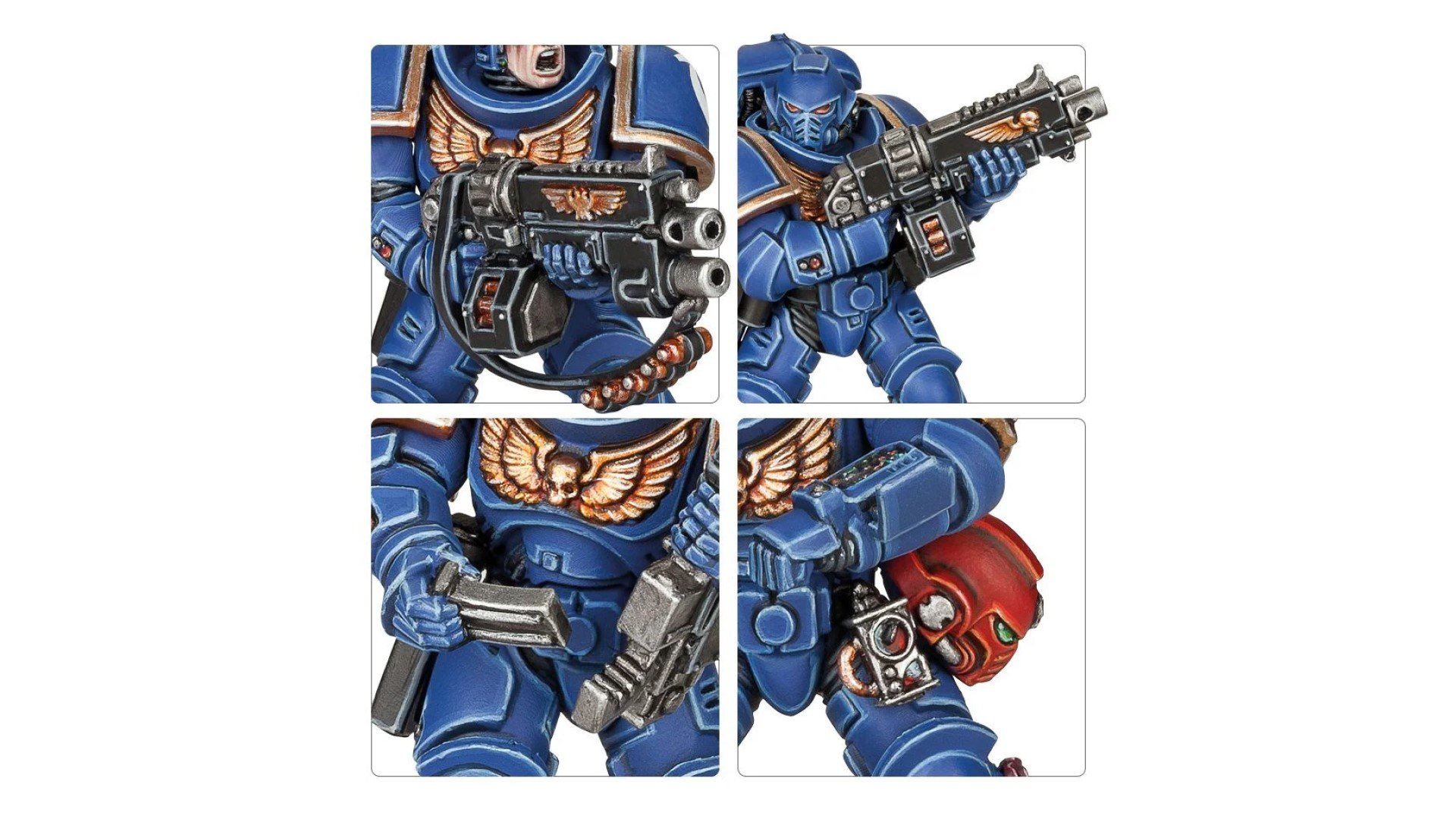
Space Marines are so tactically flexible, and have so many model options, that there are very few wrong answers here, and you can grow your force as slowly, or as quickly, as you like.
Love the fast movement and manoeuvrability of the White Scars for getting your marines into the fight? Pick up a couple of bikes too, to benefit from their biker stratagems. Before you know it, you’ll have twenty of them revving across the table, backed up by missile speeders, and be drinking in the imaginary exhaust fumes.
Addicted to the reliable offensives and straightforward force-multiplying abilities of the Ultramarines?
Paint up a couple more neat, shiny frontline Intercessor squads to open up new tactical options, and more pinpoint Bolt Rifle shots per turn – and it won’t be long before you’re lost in Roboute Guilliman‘s dreamy eyes and painting up the Primarch himself, to slather your forces in powerful aura buffs.
Space Marines are Warhammer 40k’s widest and deepest army, yet they remain among its most accessible, and, with a wider variety of possible paths to victory than almost any other faction, they always have the potential to surge once again to victories at Warhammer 40k’s top competitive tables.
After 30 years, they’re still the go-to army for most newcomers to Warhammer 40k, and with good reason – we can confidently recommend them as a way into the game and hobby alike. If you’re teetering on the edge of starting a Demi-Company of your own, we’d say go for it, don’t be afraid. You’re about to become one of the Emperor’s Angels of Death, after all – And They Shall Know No Fear.
With thanks to Nerodine for his Space Wolves Redemptor Dreadnought, and Repulsor.
Source: Wargamer



